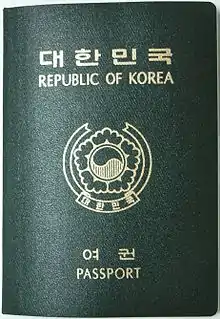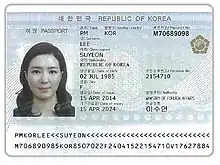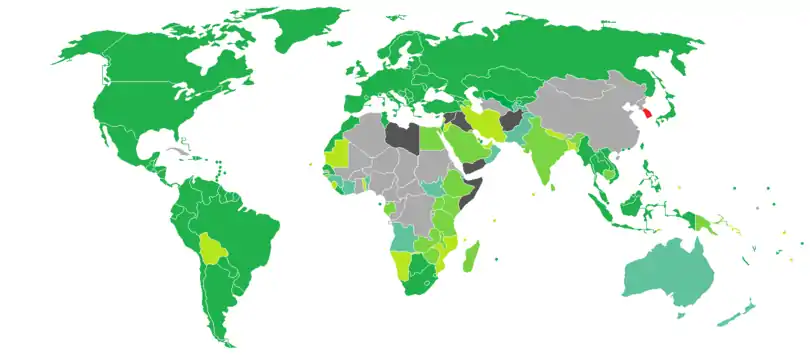Republic of Korea passport
The Republic of Korea passport (Korean: 대한민국 여권, romanized: Daehan Minguk yeogwon) is issued to a South Korean citizen to facilitate their international travel. Like any other passport, South Korean passports serve as proof for passport holders' personal information, such as nationality and date of birth. South Korean passports also indicate the holder's resident registration number, unless the holder does not have one (however a new version of the passport from 2021 will remove the bearer's resident registration number). (The next generation Epassport date has been moved aim Covid 19)South Korean passports are issued by the Ministry of Foreign Affairs and have been printed by the Korea Minting and Security Printing Corporation (KOMSCO) since 1973.[5]


| Republic of Korea passport 대한민국 여권 | |
|---|---|
 The front cover of a contemporary Republic of Korea biometric passport | |
| Type | Passport |
| Issued by | |
| First issued | 1948 (first version)[1] 25 August 2008[2] (biometric passport) 20 April 2017 (passport with braille added for blind people)[3][4] |
| Purpose | Identification |
| Eligibility | South Korean citizenship |
| Expiration | 10 years (18 years old and older) |
| Cost | ₩50,000 (24 pages) ₩53,000 (48 pages) |
Types
- Ordinary passport: Issued to normal citizens.
Ordinary passports are issued for one, five, or ten years of validity, depending on age of bearer (see below for details).
- Official passport: Issued to members of the National Assembly and civil servants.
- Diplomatic passport: Issued to diplomats and nationals who serve under diplomatic terms are given this special passport. These passports guarantee special treatment in other countries.
Expiration & Cost[6]
| Type | Multiple/Single | Validity | Number of Pages | Cost |
|---|---|---|---|---|
| Biometric | Multiple | 10 Years (18 or above) | 48 | KRW ₩53,000 |
| 24 | KRW ₩50,000 | |||
| 5 Years (under 18) | 48 | KRW ₩45,000
(KRW ₩33,000 for under 8) | ||
| 24 | KRW ₩42,000
(KRW ₩30,000 for under 8) | |||
| Below 5 Years[7] | 24 | KRW ₩15,000 | ||
| Single | Below 1 Year | 24 | KRW ₩20,000 | |
| Non-Biometric[8] | Single | Below 1 Year | 14 | KRW ₩15,000 |
- KRW ₩25,000 for a new passport with the same date of expiry as one's previous passport.
- KRW ₩5,000 to change the details on the old passport.
Physical appearance
South Korean passports are dark green, with the National Emblem of the Republic of Korea emblazoned in gold in the centre of the front cover. The word '대한민국' (Korean) and 'REPUBLIC OF KOREA' (English)
are inscribed above the Emblem whereas '여권' (Korean), 'PASSPORT' (English) and the international e-passport symbol (![]() ) are inscribed below the Emblem.
) are inscribed below the Emblem.
Difference with DPRK passport
In North Korea the word passport is spelled 려권 (lyeogwon), whereas in South Korea the same word is written 여권 (yeogwon).

Identity Information Page
- Photo of the passport holder
- Type (PM or PR or PS) PM passports can be used for multiple entries while PS passports are valid for a single entry. PR passports are for Koreans who are permanent residents of countries other than Korea.[9] However, the PR type passport has been abolished as of 21 December 2017 and permanent residents of other countries now get a normal passport[10]
- Issuing country code - KOR
- Passport number (Includes a total of nine digits. In the newly issued passports starting 25 August 2008, the Passport Number will retain the same 9 digits but the Issued Local code will be changed to a single letter M noting PM passports and S for PS passports. The rest of the 8 digits will be the serial number.)
- Surname - (Passports from many other nations such as Bulgaria[11] and Greece[12] have people's names written in local script then in the Latin alphabet. However, in a South Korean passport, only the Latin alphabet is permitted for use in the Surname and Given name sections. Their local script name is written in the Hangul name section.)
- Given names
- Nationality - Republic of Korea
- Date of birth
- Date of issue
- Date of expiry
- Sex
- Personal ID number (Resident registration number of South Korea); however, prior to 2015, South Korean passports issued to Zainichi Koreans did not have resident registration numbers, reflecting their statutory exemption from taxation and conscription in South Korea (Conversely, Zainichi Koreans were not allowed to vote.[13] However, from 2012, all Korean passport holders are eligible to vote,[14] and in 2015, Zainichi Koreans were allowed to obtain a resident registration number regardless of their statutory exemptions[15]).
- Issuing authority - Ministry of Foreign Affairs
- Hangul name
Passport note
The note inside South Korean passports are written in both Korean and English. The message in the passport, written by the South Korea's Minister of Foreign Affairs, states:
In Korean:
- 대한민국 국민인 이 여권소지인이 아무 지장 없이 통행할 수 있도록 하여 주시고 필요한 모든 편의 및 보호를 베풀어 주실 것을 관계자 여러분께 요청합니다.[Note 1]
In English:
- The Minister of Foreign Affairs of the Republic of Korea requests all whom it may concern to permit the bearer, a national of the Republic of Korea, to pass freely without delay or hindrance and to give every possible assistance and protection in case of need.
Biometric passport
The South Korean government has been issuing biometric passports since February 2008 for diplomats and government officials. They have been issuing this type of passport to all of their citizens since 25 August 2008.
The South Korean Ministry of Foreign Affairs formed the "Committee for promoting e-passports" in April 2006, and it was scheduled to issue biometric passports in the second half of 2008. On 4 September 2007, the media reported that the South Korean government decided to revise its passport law to issue biometric passports which include fingerprint information, first to the diplomats in the first quarter of 2008, and the rest of the public in the second half of the year. Some civil liberties have caused some controversy over the fingerprinting requirement because the ICAO only requires a photograph be recorded on the chip.
On 26 February 2008, the South Korean legislature passed a revision of the passport law. A new biometric passport was issued to diplomats in March, and to the general public shortly thereafter. Fingerprinting measures would not be implemented immediately; however, they began 1 January 2010.
The appearance of the new biometric passports is almost identical to the former machine-readable versions, and they both have 48 pages. However, the space for visas was reduced by six pages. These pages are now reserved for identification purposes, notices and other information, as well as the bearer's contacts. In the new biometric passports, the main identification page has moved to the second page from inside the front cover. The note from the Foreign Affairs Minister is still shown on the front page and the signature is shown on the page after photo identification.
The new biometric passport incorporates many security features such as colour shifting ink, hologram, ghost image, infrared ink, intaglio, laser perforation of the passport number (from the third page to the back cover), latent image, microprinting, security thread, solvent sensitive ink, and steganography.[5]
Inside the backcover, a caution for the biometric chip is written both in Korean,
"주의 – 이 여권에는 민감한 전자칩이 내장되어 있습니다. 접거나 구멍을 뚫는 행위 또는 극한 환경(온도,습도)에의 노출로 여권이 손상될 수 있으니 취급에 주의하여 주시기 바랍니다."
and in English,
"This passport contains sensitive electronics, For best performance please do not bend, perforate or expose to extreme temperatures or excess moisture."
The passport holders' contact information that was originally held inside the backcover has also been moved to the last page of the new passport.
New passport issued from 2021
From 2021 onwards, the ministry of foreign affairs will issue a new biometric passport. The passport will be redesigned entirely with some improvements in security. The identity information page will be made of polycarbonate making it much harder to forge. The colour of the cover of the ordinary passport will change from green to blue. Personal ID number (Resident registration number of South Korea) will be removed from the passport for greater security. The new passport will be issued from June 2020 for diplomatic and official passports holders and December 2020 for those holding an ordinary passport.

However due to global COVID-19 pandemic, the number of traveling citizens declined resulting in the delaying of the new passport production until late 2021 or whenever the current passport stock runs out. [16] Diplomatic and officials passport will be issued as planned.
Production
As of January 2009, the Korea Minting and Security Printing Corporation takes eight hours to produce the new biometric passport and is capable of producing 26,500 passports per day.[5]
Visa free travel
Visa requirements for South Korean citizens are administrative entry restrictions by the authorities of other states placed on citizens of Republic of Korea. As of 15 January 2019, South Korean citizens had visa-free or visa on arrival access to 189 countries and territories, ranking the South Korean passport second in the world in terms of travel freedom (tied with the Singaporean passport, and one ranking down from the Japanese passport) according to the Henley Passport Index.[17] Additionally, Arton Capital's Passport Index currently rank the South Korean passport third in the world in terms of travel freedom, with a visa-free score of 165 (tied with Danish, Dutch, French, Finnish, Italian, Luxembourgish, Norwegian, Singaporean, Spanish, Swedish and United States passports), as of 15 January 2019.[18]
As of October 2018, the passports of South Korea, Brunei and Chile are the only ones to provide visa-free access to all G8 countries.
Inter-Korea travel
The South Korean (Republic of Korea) constitution considers North Korea (Democratic People's Republic of Korea) as part of its territory, although under a different administration. In other words, the South does not view going to and from the North as breaking the continuity of a person's stay, as long as the traveler does not land on third country, i.e. non-Korean, territory.
However, because of the political situation between the South and the isolated socialist Juche government of North Korea, it is almost impossible to enter the North from the South across the Korean DMZ (exiting South Korea via the northern border). Tourists wishing to enter North Korea have to pass through another country, and most enter from China, because most flights to/from Pyongyang serve Beijing.
South Koreans are generally not allowed to visit North Korea, except with special authorizations granted by the Ministry of Unification and North Korean authorities on a limited basis (e.g. workers and businessmen visiting or commuting to/from Kaesong Industrial Complex). South Koreans who are allowed to visit North Korea are issued a North Korean visa on a separate sheet of paper, not in the South Korean passport. The Republic of Korea passport can be used to enter North Korea, because passport is one of the government's approved identity documents, but it is being only to prove the bearer's identity, not to determine the bearer's legal residence.[19] South Koreans can also use other government approved identity documents such as National ID Card and Driver's License, because the South Korean government treats North Korea as part of South Korea and expects South Korean IDs to be accepted.
In 1998, visa-free travel to the tourist resort of Mount Kumgang and the Kaesong Industrial Region was made possible under the "sunshine policy" orchestrated by South Korean President Kim Dae-jung. Those wishing to travel across the DMZ were given special travel certificates issued by the Ministry of Unification through Hyundai Asan. In July 2008, a female tourist named Park Wang-ja was shot to death by a North Korean guard on a beach near Mount Kumgang, which led to the suspension of the tours. As of March 2010 all travel across the DMZ has now been suspended due to increasing tensions between North and South Korea. However in 2018, Kim Jong-un and others went to South Korea through the DMZ and met up with South Korean officials. They discussed reunification.[20]
There are four land border checkpoints in South Korea for inter-Korea travel.
Restricted nations
The South Korean government has banned Afghanistan, Iraq, Libya, Somalia, Syria and Yemen as travel destinations for safety reasons.[21][22]
See also
Notes
- In Korean mixed script: 大韓民國 國民인 이 旅券 所持人이 아무 支障 없이 通行할 수 있도록 하여 주시고 必要한 모든 便宜 및 保護를 베풀어 주실 것을 關係者 여러분께 要請합니다.
References
- http://m.dongponews.net/news/articleView.html?idxno=13576
- http://www.korea.net/NewsFocus/policies/view?articleId=145309
- but sometimes passport scan error occurs because of braille. So now braille is added only if requested.
- http://english.komsco.com/products/passport.asp
- "외교부 여권안내 홈페이지". www.passport.go.kr (in Korean). Retrieved 2019-12-12.
- For those who need to complete military service (Conscription in South Korea).
- Only issued in case of emergency.
- http://www.passport.go.kr/board/story.php?idx=187&sel=1
- http://overseas.mofa.go.kr/bh-ko/brd/m_10947/view.do?seq=1346294
- "Biodata page". European Communities.
- "Biodata page". European Communities.
- Ryang, Sonya; Lie, John (2009), Diaspora without homeland: being Korean in Japan, University of California Press, p. 11, ISBN 978-0-520-09863-3
- "[특집일반]자이니치, 한국에 투표하다". h21.hani.co.kr (in Korean). Retrieved 2017-05-23.
- "Ministry of the Interior".
- https://www.passport.go.kr/new/board/data.php?idx=5450&sel=1
- "Global Ranking - Visa Restriction Index 2018" (PDF). Henley & Partners. Retrieved 23 March 2018.
- https://www.passportindex.org/byRank.php
- http://www.hyundai-asan.com/customer/faq.jsp?page=2§ion=2#. Missing or empty
|title=(help) - https://www.washingtonpost.com/news/worldviews/wp/2018/04/27/as-kim-walks-across-border-germany-has-an-idea-how-to-tear-down-that-wall-for-real/%3Futm_term%3D.a0c68c66749e&sa=U&ved=0ahUKEwjn8LHEqO7aAhVCbrwKHQj_CiIQFggOMAE&usg=AOvVaw0sI7KwTz1L2q0K3qBIMCmE
- S. Korea extends travel ban on four nations, Yonhap News, July 23, 2013
- S. Korea imposes travel ban on violence-ravaged Libya, Yonhap News, July 30, 2014
